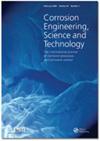Effect of post-welding sensitisation on the degree of sensitisation of the welding zones of AISI 304 resistance spot welding joints studied by using an electrochemical minicell
IF 1.5
4区 材料科学
Q4 MATERIALS SCIENCE, MULTIDISCIPLINARY
Corrosion Engineering, Science and Technology
Pub Date : 2023-08-11
DOI:10.1080/1478422X.2023.2243727
引用次数: 0
Abstract
ABSTRACT In resistance spot welding (RSW) joints of austenitic stainless steel (ASS), a small-scale electrochemical cell (minicell) was used for assessing individually, on each of the three welding zones, of size less than 1000 µm (fusion zone (FZ), heat affected zone (HAZ) and base metal (BM)), the combined effect of a RSW process and post-welding sensitisation on the degree of sensitisation (DOS). The results show that the three welding zones have different microstructures that make each of them respond differently to post-welding sensitisation. The DOS varies with post-welding sensitisation time in all three welding zones, but it varies at a different rate in each welding zone (the highest rate in the FZ). This variation is due to the fact that when the DOS reaches a certain level, which is observed when plotting the reactivation charge (Qr) versus the post-welding sensitisation time, a microstructural regeneration occurs.用电化学微型电池研究焊后敏化对AISI 304电阻点焊接头焊接区敏化程度的影响
摘要在奥氏体不锈钢(ASS)的电阻点焊(RSW)接头中,使用小型电化学电池(微型电池)对尺寸小于1000的三个焊接区中的每一个进行单独评估 µm(熔合区(FZ)、热影响区(HAZ)和母材(BM)),RSW工艺和焊后敏化对敏化程度(DOS)的综合影响。结果表明,三个焊接区具有不同的微观结构,这使得它们对焊后敏化的反应不同。在所有三个焊接区域中,DOS随焊后敏化时间而变化,但在每个焊接区域中以不同的速率变化(FZ中的最高速率)。这种变化是由于当DOS达到一定水平时(在绘制再激活电荷(Qr)与焊后敏化时间的关系图时观察到),微观结构再生发生。
本文章由计算机程序翻译,如有差异,请以英文原文为准。
求助全文
约1分钟内获得全文
求助全文
来源期刊

Corrosion Engineering, Science and Technology
工程技术-材料科学:综合
CiteScore
3.20
自引率
5.60%
发文量
58
审稿时长
3.4 months
期刊介绍:
Corrosion Engineering, Science and Technology provides broad international coverage of research and practice in corrosion processes and corrosion control. Peer-reviewed contributions address all aspects of corrosion engineering and corrosion science; there is strong emphasis on effective design and materials selection to combat corrosion and the journal carries failure case studies to further knowledge in these areas.
 求助内容:
求助内容: 应助结果提醒方式:
应助结果提醒方式:


